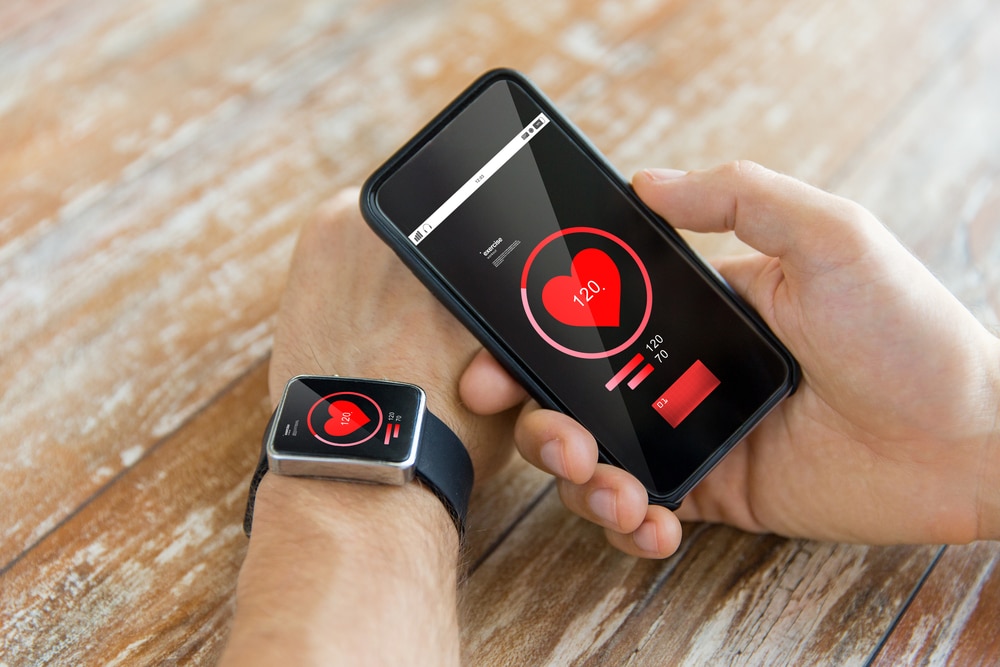During exercise, your heart rate increases as your heart pumps more oxygen to your muscles. However, after you are done, your heart rate should drop. Would you like to know what is the normal heart rate after exercise, and why do you need to track it? Our comprehensive guide on what your heart rate is telling you throughout training will answer this. In this read, find out what normal resting, active, and after exercise heart rates should be for your age!
What Is The Heart Rate?
People often confuse the heart rate with the pulse rate. The pulse rate refers to the number of times per minute that the arteries expand and contract when responding to the heart’s pumping action (7).
The pulse rate is equivalent to your heartbeat. This is because the contractions of your heart are responsible for the increased blood pressure in your arteries, leading to a pulse (4). Heart rate though, is the number of times the heart beats within one minute (4).
It is important to understand your normal heart rate and what it is after different activities, because this signifies the heart’s efficiency. A healthy heart supplies the body with the right amount of blood at the correct rate (4).
What Is A Normal Resting Heart Rate?
According to Mayo Clinic, a normal resting heart rate for healthy adults should range from 60 to 100 beats per minute (7). Experts acknowledge that a lower resting heart rate implies that your heart function is more efficient and has better cardiovascular fitness (7). You will find that a seasoned athlete can have a normal resting heart rate of around 40 beats per minute (7).
Keep in mind that other factors besides your fitness and activity levels affect your heart rate. They include your age, body size, emotions, medications, body position, and lifestyle habits like smoking (7).
An unusually high normal resting heart rate indicates an underlying problem. Knowing this, consult your doctor if you have a resting heart rate that consistently reads 100 beats per minute (7). This rapid heart rate is known as tachycardia.
Similarly, talk to your doctor if you have a resting heart rate of below 60 beats per minute (bradycardia), yet you are not a seasoned athlete (7). This is also alarming and is characterized by signs such as shortness of breath, dizziness, or fainting (7).
Read More: Does Running Build Muscle? The Truth About Anaerobic Exercise And Bodybuilding
What Is A Healthy Active Heart Rate During Exercise?
When you exercise, you want your heart rate to increase to give your muscles enough oxygen. However, you do not want it to go up too much.
The active heart rate varies as it is influenced by the type of activity and your age. Take a look at the active heart rates in respect to the type of activity:
-
Moderate Intensity Activity
For this exercise, experts recommend an ideal active heart rate to range from 64% to 76% of your maximum heart rate (3). As we mentioned earlier, you calculate your maximum heart rate by subtracting your age from 220 (3).
Let us do some math to find the active heart rate of a 20-year old. Here are the steps to follow to determine the active heart rate:
- First, you must subtract the age from 220 to acquire the maximum heart rate. So, 220-20=200.
- Second, you find 64% of 200 (0.64 x 200 = 128)
- Third, find 76% of 200 (0.76 x 200 = 152)
So, a 20-year’s old active heart rate should range from 128 to 152 bpm when performing moderate-intensity exercises.
-
Vigorous Intensity Exercise
Any vigorous-intensity activity will demand more work from your heart, which means that the active heart rate will be higher. Experts recommend that your active heart rate range from 77% to 93% when performing a vigorous-intensity activity (3).
Let us also use the 20-year old age example to calculate this rate. Below are the required steps:
- Calculate the maximum heart rate (220-20=200).
- Calculate 77% of 200 (0.77 x 200 = 154)
- Calculate 93% of 200 (0.93 x 200 = 186)
Based on this math, this means that the active heart rate of a 20-year old performing a vigorous-intensity activity should range from 154 to 186 bpm (3). Experts also acknowledge that vigorous exercise is the best way to lower your resting heart rate and increase your maximum aerobic capacity and heart rate (6).
However, they do state that it is impossible to maintain a maximum heart rate for several minutes. So, you are advised to set a specific percentage of your maximum heart rate as your target during exercise (6).
If you wish to cinch your waist, tone up your bat wings, blast away the muffin top – our fitness app was created to cater to all your needs! BetterMe won’t give excess weight a chance!
How To Set Your Target Heart Rate Zone
You have to first determine your target heart rate zone. This requires you to do a little bit of math to get this heart rate. Generally, you are advised to use the heart rate reserve (HRR) method to calculate this rate. It requires you to (2):
- Subtract 20 from your age to get your maximum heart rate.
- Calculate the number of times your heart beats per minute when at rest, preferably in the morning. It ranges from 60 to 100 beats per minute for an average adult.
- Calculate your HRR by subtracting your resting heart rate from your maximum heart rate.
- Multiple the HRR by 0.7 and then add the answer to your resting heart rate.
- Multiply the HRR by 0.85, and then add the rest to your resting heart rate.
The two numbers you get are your average target heart rate zone for vigorous exercise intensity. Your heart rate after a vigorous activity should be between these two numbers.
What Is The Normal Heart Rate After Exercise?
We have looked at the normal resting heart rate and the active heart rate during exercise. So, now, we will discuss the normal heart rate after exercise.
Again, this rate is highly based on your age and the activity you were performing. The rate will differ because your heart is beating differently as it approaches the normal resting heart rate. So, the normal rate 30 seconds after exercise is not equal to that taken 20 minutes after exercise.
An easier way to measure your heart rate after exercise is to wear a chest monitor or fitness bracelet (4). You now know that a normal resting heartbeat should range from 60 to 100 beats per minute.
If not, you can test your heart rate by counting your pulse rate. Place two fingers between the bone and tendon in your wrist and count the number of beats per 15 seconds. Then, multiply this number by four to get your pulse rate.
This will give you the pulse rate per minute. Again, this is a reflection of your heart rate. You can do this several times to determine your heart rate after exercise.
Read More: Is Pilates Good For Weight Loss? Why You Should Make This Practice Part Of Your Exercise Routine
Before we sign out, let us do a quick run-through of some critical pointers. They are as follows:
-
The Time It Takes Your Heart Rate To Return To Normal After Exercise
The intensity of the activity influences the time it takes. The more intense the exercise is, the longer your heart rate takes to return to its resting rate. Since most people are unaware of this, they often panic when their normal heart rate 10 minutes after exercise differs from readings taken 15 minutes after a workout.
Now you know that intensity influences the differences. For example, experts reveal that it should take your heart 10 to 20 minutes to return to the normal rate if you perform a low-intensity aerobic exercise (3).
Should your heart rate slow to return to normal after exercise? This is yet another concern of most people. Fitness experts state that a slow heart rate recovery after exercise may indicate impaired parasympathetic tone, which is one of the risk factors of cardiovascular mortality (1).
-
Your Heart Rhythm
You must also be keen and listen to your heart rhythms. If your heart has a rapid, sluggish, or abnormal rhythm, you need to talk to your doctor. The most common abnormal rhythm experienced by most people is atrial fibrillation, which replaces the normal beat with an erratic pattern (4).
Similarly, if you feel a missed, skipped, or extra beat, it is essential to let your doctor know. Although extra beats, also known as ectopic beats, are harmless and require no treatment, it would not hurt to let your doctor know about them (4).
BetterMe is your fast-track ticket to a long-lasting weight loss! Tailor your fitness journey and maximize your results with just a couple of swipes!
The Bottom Line
Your normal resting heart rate is different from your active heart rate and heart rate after exercise. You can measure the normal heart rate after exercise by taking your pulse rate. Be warned, though, a very low or abnormally high heart rate is alarming, and you need to talk to your doctor immediately.
Get your personalized
meal plan!
DISCLAIMER:
This article is intended for general informational purposes only and does not address individual circumstances. It is not a substitute for professional advice or help and should not be relied on for decision-making. Any action you take upon the information presented in this article is strictly at your own risk and responsibility!
SOURCES:
- Abnormal heart rate recovery after exercise predicts coronary artery disease severity (2011, pubmed.ncbi.nlm.nih.gov)
- Exercise intensity: How to measure it (2021, mayoclinic.org)
- How to calculate active heart rate (2021, medicalnewstoday.com)
- What should my heart rate be? (2021, medicalnewstoday.com)
- What to Know About Your Heart Rate (2020, webmd.com)
- What your heart rate is telling you (2020, health.harvard.edu)
- What’s a normal resting heart rate? (2020, mayoclinic.org)











